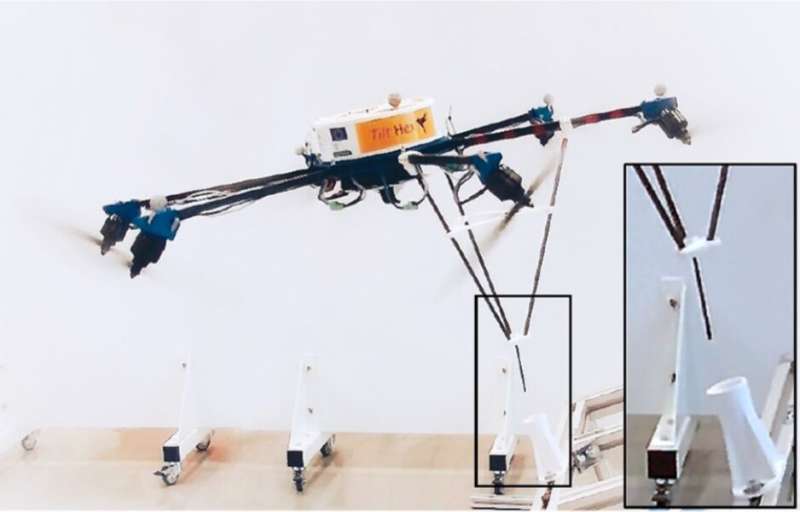July 10, 2019 feature
A technique to enhance physical interaction in aerial robots

In recent years, aerial robots have become increasingly popular, with potential applications in a variety of fields. Many of these robots are primarily designed to fly around and collect visual data from their surrounding environment, yet some are also able to grasp, carry or even assemble objects.
Equipping aerial robots with advanced physical interaction capabilities could be incredibly useful, as it would allow them to complete more complex tasks. However, due to the complex nature of aerodynamics, this has often proved very challenging, particularly when a vehicle is close to surfaces.
Researchers at the University of Cassino and Southern Lazio, Université de Toulouse and the University of Basilicata have recently introduced a new paradigm that enables 6-D interaction control in aerial robots. Their approach, outlined in a paper published in SAGE's International Journal of Robotics Research, could pave the way toward the development of more effective aerial systems that perform better than existing robots in aerial manipulation and physical interaction tasks.
The new paradigm proposed by the researchers, called 6-D flying end effector, can be applied to most, if not all, fully actuated systems that are able to track a full-pose trajectory with the end effector. In the study, it was specifically applied to Tilt-Hex, a novel aerial robot, enabling the independent control of its linear and angular acceleration. This ultimately allowed the robot to instantaneously counteract any wrench it encountered when interacting with its environment.
"By exploiting its tilted propeller actuation, the robot is able to control the full 6-D pose (position and orientation independently) and to exert a full-wrench (force and torque independently) with a rigidly attached end effector," the researchers explain in their paper. "Interaction is achieved by means of an admittance control scheme in which an outer loop control governs the desired admittance behaviour (i.e. interaction compliance/stiffness, damping, and mass) and an inner loop based on inverse dynamics ensured full 6-D pose tracking."
The paradigm developed by the researchers estimates interaction forces using an inertial measurement unit (IMU)-enhanced momentum-based observer. When integrated with known robotic algorithms it can achieve wrench estimation, as well as motion and interaction control. Interestingly, this "integrated system" does not require a force sensor in its basic configuration and works even with a minimal sensor suite.
The researchers have evaluated the effectiveness of the 6-D flying end effector paradigm in a series of experiments, focusing on four case studies: a hard-touch and slide on a wooden surface (i.e. the sliding surface task), a tilted peg-in-hole task, an admittance shaping experiment, and a task in the presence of time-varying interaction forces. These evaluations yielded very promising results, demonstrating the versatility and robustness of the approach even in the presence of environmental uncertainties.
Moreover, the new paradigm was found to outperform other techniques for aerial manipulation in its capabilities, as well as in its reliability, complexity and costs. It could thus aid the development of more advanced aerial systems that perform better in manipulation and physical interaction tasks.
"In the future, we will seek full autonomy of the system by replacing the motion capture system with a full on-board state estimation," the researchers write in their paper. "Furthermore, we will work on differentiation contact forces on the tool tip and disturbances on the platform (e.g. wind gusts)."
More information: Markus Ryll et al. 6D interaction control with aerial robots: The flying end-effector paradigm, The International Journal of Robotics Research (2019). DOI: 10.1177/0278364919856694
© 2019 Science X Network



















